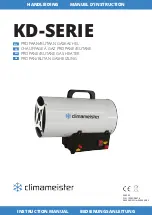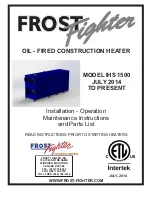
9
CPVC (Schedule 40 DWV, ASTM F-438)
ABS (Schedule 40 DWV, ASTM D-2661)(Not permitted
in Canada)
NOTICE: Use of PVC cellular core (ASTM-F891), ABS
Schedule 40, DWV cellular core (ASTM –F628), or
Radel® (polyphenylsulfone) in non-metallic venting
systems is prohibited.
The unit may be vented horizontally through a wall
or vertically through the roof. Pipe runs must be ad-
equately supported along both vertical and horizontal
runs. Maximum unsupported span is recommended
to be no more than 4 feet. It is imperative that the
first hanger be located on the horizontal run immedi-
ately adjacent to the first 90-degree elbow from the
vertical rise or at the blower outlet, in the case of a
horizontal blower position. The support method used
should isolate the vent pipe from floor joists or other
structural members to help prevent the transmission
of noise and vibration.
DO NOT
support, pin, or other-
wise secure the venting system in a way that restricts
the normal thermal expansion and contraction of the
chosen venting material.
If the water heater is being installed as a replacement
for an existing power vented water heater, a thorough
inspection of the existing venting system must be
performed prior to any installation work. Verify that
the correct materials, as detailed above, have been
used and that the minimum or maximum vent length
and terminal locations, as detailed in this manual,
have been met. Carefully inspect the entire venting
system for any signs of cracks or fractures, particu-
larly at the joints between elbows or other fittings and
the straight runs of vent pipe. Check the system for
signs of sagging or other stresses in the joints as a
result of misalignment of any components in the sys-
tem. If any of these conditions are found, they must
be corrected in accordance with the venting instruc-
tions in this manual before completing the installation
and putting the water heater into service.
VENT PIPE CONNECTION —
Note: It is recommended that a suitable rubber coupling
is used on the outlet vent connection.
Refer to Figure 4, for connecting the vent pipe to the
water heater. These models can be vented either as a
direct vent or as a power vent water heater.
NOTICE: If the unit is installed as a power vent water
heater, the vent terminal with screen must still be
installed on the inlet air side.
Before starting the vent installation, careful planning
should be given to the routing and termination of the
vent pipes. The length of the vent pipes (inlet and
outlet) should be kept to a minimum. Also, see Figure
11 for vent terminal placement. Refer to the venting
charts in Table 1 for the pipe sizes and the total equiv-
alent length of pipe that can be used.
DO NOT
exceed
the equivalent length of pipe in the charts.
Depending on the size of pipe selected for venting
the water heater, it may be necessary to use a fitting
for stepping up or down in pipe size to connect to the
water heater. All models are shipped with 3" vent ter-
minals with screen. If another size of pipe is used for
venting the unit, the proper vent
terminal must be installed.
When the unit is vented as a direct vent, through a
side wall, the vent terminals must be on the same
exterior wall mounted horizontally and maintain a
minimum distance between the centers of 24" (61 cm).
See Figures 8, 9, and 11 for other vent terminal re-
strictions.
JOINING PIPES AND FITTINGS – All pipe, fittings,
solvent cement, primers, and procedures, must con-
form to American National Standards Institute and
American Society for Testing and Materials (ANSI/
ASTM) standards in the U.S. For Canada, all pipe, fit-
tings, solvent cement, primers, and procedures must
conform to ULC-S636 and vent manufacture specifi-
cations.
CEMENTING JOINTS – All joints in the vent piping
must be properly sealed. Use of the following material
is recommended:
PVC materials should use ASTM D-2564 grade
cement.
CPVC materials should use ASTM F-493 grade
cement.
ABS materials should use ASTM D-2235 grade
cement.
(ABS is not allowed in Canada)
Cleaner-Primer and Medium Body Solvent Cement
1. Cut the pipe end square, removing all jagged edges
and burrs. Chamfer the end of the pipe, and, then,
clean the fitting socket and pipe joint area to remove
all dirt, grease, and moisture.
2. After checking pipe and socket for proper fit, wipe the
socket and pipe with cleaner-primer. Apply a liberal
coat of primer to the inside surface of the socket and
the outside of the pipe.
DO NOT
allow the primer to
dry before applying the cement.
3. Apply a thin coat of cement evenly in the socket.
Quickly apply a heavy coat to the pipe end. Insert the
pipe into the fitting with a slight twisting motion until it
bottoms out.
NOTICE: Cement must be fluid; if not, re-coat.
4. Hold the pipe fitting for 30 seconds to prevent the ta-
pered socket from pushing the pipe out of the fitting.
5. Wipe all excess cement from the joint with a rag.
Allow 15 minutes for drying before handling. Cure time
will vary according to fit, temperature, and humidity.
NOTICE: Stir the solvent cement frequently while using.
Use a natural bristle brush or the dauber supplied
with the can. The proper brush size is one inch.
FOR PROPER INSTALLATION:
CAUTION
!
•
DO NOT use solvent cement that has become
curdled, lumpy or thickened.
•
DO NOT thin solvent cement. Observe shelf
precautions printed on the containers.
Installation
Figure 4.
—
Vent Pipe Connection Locations
Air Inlet
Connection










































